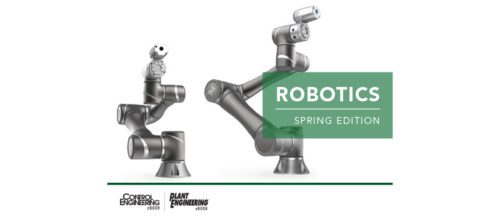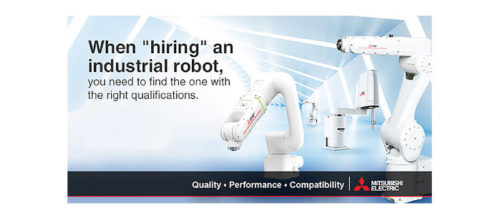Where, when to apply pneumatic actuation
Back to Basics: Knowing why, where, and when to apply pneumatic actuation improves performance and efficiencies and lowers cost
From commercialization of servo pneumatic solutions to development of high-density, fieldbus-networked valve terminals, pneumatic actuation has come a long way in a few years. When manufacturers know why, where, and when to apply pneumatic actuation, performance and efficiencies improve and overall costs decrease. Technology advances dispel traditional myths concerning compressed-air systems and provide useful information on how pneumatic actuation fits into current control architectures.
End effector integration
Electric robots and electromechanical actuators are commonly used in handling applications that require complex and flexible motion control. If the handling system design is electric, the application engineer may automatically assume that the end effector should also be electric. This can be an expensive decision because many applications are better suited for a pneumatic mechanical gripper or vacuum suction cups.
Suction cups are ideal for handling workpieces of different sizes, shapes, and surface finishes when high positioning accuracy is not required. An example is the handling of corrugated and folding carton materials or a large matrix of items during packaging. Suction cups are also ideal for handling delicate items, such as glass and fresh produce. The initial cost of using vacuum is low, just the price of the cups and a vacuum generator. Pneumatic mechanical grippers are well suited for applications requiring high speeds or a high gripping force. In some high-intensity applications, the operational cost of vacuum generators may be prohibitive. Relatively simple calculations will indicate where this is the case.
Pneumatic grippers have several advantages and disadvantages compared to electric grippers. The advantages include high gripping forces, as stated above, lighter weight, smaller physical size, and lower initial cost. Disadvantages include limited ability to control the force, speed, or positioning. The force of a pneumatic gripper can be adjusted by varying the operating pressure, which can be done with a control valve or an analog proportional pressure valve. If regular and precise control is required, however, the gripping force of an electric gripper may be a better alternative. The speed of a pneumatic gripper can be partially controlled by using flow control valves and adjusting the operating pressure, but this method is not precise, and very slow speeds cannot be achieved without experiencing stick-slip of the piston.
Washdown actuators
Food and beverage processing machinery may use several types of actuators, including rod-style, rotary, or rodless. The rod-style actuator is the most common type due to its versatility and because it is inherently sealed and a better solution for washdown environments. Pneumatic rod-style actuators are widely used in the food and beverage industry due to low cost and the fact that most food processing and packaging applications do not require an electric actuator’s precise or flexible positioning capabilities. Furthermore, electric actuators are not as well suited for food grade and/or wash-down environments as a pneumatic system is, because pneumatics can have associated electronics located in a nearby cabinet well away from the machine requiring wash down. The electric actuators may also need to be food grade, and the relatively small supplier base for these actuators limits the number of choices.
There is a persistent myth that pneumatic components do not have a place in food and beverage applications because of potential contaminants carried in the compressed air system. Many valve manufacturers now produce special products that contain food grade grease and are designed such that compressed air that comes in contact with food product is safe. This enables users to incorporate low-cost pneumatic solutions in close proximity to food and beverage products while still complying with FDA rules and regulations.
Multiple position control
When an application requires an actuator with multiple positions, some engineers might automatically think electric. However, a pneumatic solution may meet the application requirements, most likely at a cost savings compared to an electric solution. Pneumatic rod-style actuators typically provide only two positions via continuous end-to-end motion, but it is possible to achieve up to five positions. This can be done with a multiposition cylinder, which is one actuator consisting of up to four piston rods and air connections for each piston. Other ways to achieve multiple positions with pneumatic actuators include intermediate stop modules for rodless actuators that use a pneumatically driven mechanical flag to stop the carriage, mounting two rod-style actuators back to back, and using external stops, such as hydraulic shock absorbers.
If true motion control (multipositioning, speed and force control) are required, then servo pneumatics should be considered. Pneumatic suppliers offer an easy servo-pneumatic integration route that relies on a control platform networked to the machine or manufacturing line controller. Pneumatic servos can provide higher thrust force than electric servos provide.
Extremely accurate, high speed
New innovations in electromechanical components allow for today’s machines to operate at increasingly higher speeds, while maintaining pinpoint precision. Typically pneumatics cannot match these defining criteria. However, not all aspects of a system require the accuracy provided by an electric drive. In fact, specifying an electromechanical component for every task will increase the costs and weight of the machine when other solutions would suffice. Hybrid solutions of electromechanical and pneumatic can offer the best of each: the cost-effectiveness of pneumatics and the speed and accuracy of electromechanical devices. For example, a three-axis gantry system that needs to position itself quickly in the x and y plane (two of the axes) can be set up with electric drives to ensure exact positioning. Then the third axis, the z plane, which is simply required to raise or lower to pick up or drop an item, can be fitted with a pneumatic valve and cylinder combination. This combination provides several benefits to the overall gantry solution, including lowering its cost and decreasing the weight of the gantry arm, thereby reducing the strain acting on the rest of the machine.
Fieldbus controlled valves
When pneumatic valves were originally designed with electric solenoids for actuation, each had to be individually wired to a control unit. As technology advanced, valve terminals could be wired and controlled via other point-to-point connections with multi-pin or flat-ribbon connection cables.
Although these connections were an improvement, they still limited the number of solenoids used per manifold as standard connections only come in certain sizes, and as connector sizes increase, so do costs. The technology progression of valve control now allows for the integration of field bus communication technology.
This means a large number of solenoids can be included per terminal, up to 128 solenoids in some cases. High density helps minimize the effective footprint of the machine and reduces the cost since the user no longer needs to install as many valve terminals. A fieldbus solution will also require fewer connection points than a conventional system. Integrated I/O terminals like these also offer the advantage of capturing diagnostic information directly from the valve terminal. Furthermore, some I/O terminals can incorporate PLCs directly into their configuration to further decrease costs and the number of network drops required in the system. These systems also have the added benefit of minimizing, if not eliminating, latency times between commands and valve actuation, further enhancing valve/process repeatability.
Bottom line, pneumatic and electrical actuation is not an either/or proposition. Selecting the right unit or combination of units can lead to improved performance at lower overall costs.
– Mike Guelker is product manager—actuators, and Troy Sanders is valve product specialist, Festo; edited by Mark T. Hoske, content manager CFE Media, Control Engineering, Plant Engineering, and Consulting-Specifying Engineer, mhoske@cfemedia.com.
www.festo.com
https://www.controleng.com/machinecontrol
Do you have experience and expertise with the topics mentioned in this content? You should consider contributing to our CFE Media editorial team and getting the recognition you and your company deserve. Click here to start this process.



